- 1Institut de Ciències del Mar, Spanish National Research Council - Consejo Superior de Investigaciones Científicas, Barcelona, Spain
- 2Fundación Oceanogràfic de la Comunitat Valenciana, Ciudad de las Artes y las Ciencias, Valencia, Spain
- 3Department of Biological Sciences, Purdue University Fort Wayne, Fort Wayne, IN, United States
- 4Department of Sociology, Idaho State University, Pocatello, ID, United States
- 5Rosenstiel School of Marine and Atmospheric Science, University of Miami, Miami, FL, United States
- 6School of Biological Sciences, Monash University, Clayton, VIC, Australia
Sea turtles are a circumglobal taxon that receive considerable research and conservation attention; however, there is little published information about patterns of representation for people working with these species. To assess long-term trends in gender, geographic, and institutional representation within the sea turtle community, we quantified information from 7041 abstracts presented at the International Sea Turtle Symposium (ISTS) between 1988–2018. We report several key findings. (1) The number of authors per abstract doubled over the study period, suggesting greater acknowledgment of contributing individuals. (2) The proportion of female first and last authors has increased over time and at the end of the study period female first authors were in a slight majority (53%) even though last authors remained predominantly (64%) male. (3) Most researchers were from North America (45%) but representation from other continents has increased over time. (4) It was common for authors from North America (34%) and Europe (42%) to conducted research in other continents. This was far less common (<6%) for authors in Africa, Asia, Central America and the Caribbean, and South America. (5) Most authors (48%) were affiliated with academic institutions. Overall, our results reveal a slow trend toward gender equity and globalization in the sea turtle community. Increasing opportunities for underrepresented groups should therefore remain a key priority. To facilitate this process, we suggest hosting symposiums in underrepresented regions, providing grants for underrepresented individuals, developing opportunities to present abstracts remotely via hybrid events, and promoting gender equity in senior researcher positions.
Introduction
Identifying representational biases in professional environments is a vital step toward building more inclusive and diverse communities (Chachra, 2017). An interesting case study for revealing geographic and gender biases within the field of ecology would be to characterize representational patterns in sea turtle researchers and conservationists (hereafter shortened to “sea turtle community”). This is because sea turtles are a circumglobal taxon (Wallace et al., 2010) of considerable commercial and ecological importance (Tisdell and Wilson, 2001; Heithaus, 2013). In addition, sea turtles have broad charismatic appeal (Campbell and Smith, 2006) and many populations are of conservation concern (Wallace et al., 2011). In turn, this has lead to the establishment of research and conservation programs for sea turtles throughout an extensive range of countries worldwide (Mazaris et al., 2017). Studying long-term trends in geographic and gender representation within the sea turtle community may therefore provide insights into similar patterns within the field of ecology on a global scale.
Academia provides a convenient structure for assessing representation via authorship on scientific publications or conference abstracts (AlShebli et al., 2018). As authorship is not limited to a single individual and generally includes everyone considered to have made a significant contribution, publications with higher numbers of authors theoretically reflect larger collaborative networks (Moed, 1989). Importantly, larger collaborative networks can also tackle broader research questions than a single researcher (e.g., Kot et al., 2022). Such advantages of large collaborative networks are particularly relevant within the sea turtle community considering that turtles’ migratory routes, nesting beaches, and foraging areas frequently span geopolitical boundaries (e.g., Patel et al., 2015; Robinson et al., 2016). Yet, it should be noted that a higher number of authors per study does not necessarily equate to increased patterns of geographic or gender representation (Zitt, 2005).
“Parachute science” is an increasingly discussed phenomenon whereby individuals or organizations from higher-income countries establish programs in lower-income countries but fail to invest in; fully partner with; or recognize local governance, capacity, expertise, and social structures (Stefanoudis et al., 2021; de Vos and Schwartz, 2022). This has ethical implications, can led to conflicts of interest between local and international stakeholders, and may overshadow research efforts lead by local scientists (Passos et al., 2020; Haelewaters et al., 2021). The potential for parachute science may be particularly high within the sea turtle community considering that most sea turtle habitats are found in the “global South” (Wallace et al., 2010), while sea turtle projects are primarily funded and managed via volunteer-based ecotourism efforts that traditionally cater to individuals from the “global North” (Rudd et al., 2021).
Gender representation is another key topic in which several studies have highlighted worrying trends within ecology (e.g., Larivière et al., 2013; Kern et al., 2015). Overall, the proportion of female first authors has increased in recent decades; however, female first authors generally remain in the minority and only 35.2% of all articles published in 10 leading peer-reviewed ecological journals in 2016 had female first authors (Salerno et al., 2020). The discrepancy in this study was even more pronounced for last authors with only 27.9% having female last authors (Salerno et al., 2020). In addition, there is plenty of variation within specific scientific field with relation to trends in gender equality. For example, the percentage of female first authors in coral research has increased from 18% to 33% over the past three decades (Ahmadia et al., 2021) while a more robust increase from <10% to ~ 45% was seen in elasmobranch research over a similar time frame (Shiffman et al., 2020). Quantifying comparable patterns in taxon-specific fields, such as the sea turtle community, could therefore help us focus efforts on where they are needed most and help to highlight which strategies have been most effective at promoting gender equity in science.
To investigate long-term trends in geographic and gender representation in the sea turtle community, we analyzed thirty years of abstracts from the International Sea Turtle Symposium (ISTS). The ISTS provides a platform for the sea turtle community worldwide to network and share their latest findings (e.g., Casale et al., 2005; Gaughran, 2012; Pinou et al., 2019). While there are other notable sea turtle-specific meetings, such as the Australian Marine Turtle Symposium and the Mediterranean Conference on Marine Turtles, the ISTS may remains the largest international event. Representation of the presenters attending the ISTS can therefore serve as a proxy for the global sea turtle community. In addition, as the presentations given at the ISTS include studies that may never be published in peer-reviewed scientific publications (e.g., governmental reports, anecdotal observations, conservation techniques), they arguably provide a more holistic representation of the sea turtle community than would be provided by a review of exclusively peer-reviewed manuscripts.
This specific objectives of this study were to characterize changes at the ISTS over the past three decades in (1) the number of authors per abstract, (2) the percentage of male and female first and last authors, (3) the geographic patterns in the research location and the location of the author's affiliated institution, and (4) the representation of government, private, non-profit, and academic institutions.
Methods
Data source
The first ISTS was held in 1980 and was repeated annually until 2020, when subsequent events were put on hold until 2022 due to the COVID-19 pandemic. The first seven events were based around informal discussions and meetings. Since 1988, however, the event followed a more structured format based around several days of short presentations (8-20 mins each). The abstracts from these presentations were compiled into a “Book of Abstracts” and published online after each symposium at https://www.internationalseaturtlesociety.org/publications/proceedings/ or https://repository.library.noaa.gov/.
We gleaned data from every abstract presented in the annual Book of Abstracts between the 8th ISTS in 1988 and the 38th in 2018 (for full references see Supplementary Materials 1). However, we were unable to compile data from the 32nd, 35th, 37th, and 39th events as their Book of Abstracts had not been made publicly available at the time of writing this manuscript. The information that we gleaned from each abstract is detailed in the sub-headers below. We did not access, or report on, any additional personal information beyond what was shared within each Book of Abstracts. Furthermore, no individuals or institutions will be named directly in this manuscript. The full dataset can be accessed at https://doi.org/10.5061/dryad.tmpg4f518
Presentation format
We noted the location of each ISTS event, the number of abstracts per year, and whether each abstract was given as an oral or a poster presentation. Presentations were occasionally made in other formats, such as video presentations, but for consistency we excluded these abstracts from this analysis. Similarly, we did not include abstracts from key-note presentations.
Number of authors per abstract
We recorded the number of authors, including the first author, for each abstract. When a collective of individuals were listed under a single heading (e.g., J. Jonah Jamieson and volunteers), the collective was counted as a single individual.
Inferring gender of first and last author
We inferred the gender of first and last authors by consulting the Oxford Dictionary of First Names (Hanks et al., 2006) to determine which names were typically denoted as male, female, or gender neutral. For example, Alexander would be listed as male, Alexandra would be listed female, and Alex would be listed as gender neutral. If the author initialized their first name, we used the next name they had listed as long as it was not their last name (i.e., J. Jonah Jamieson would be shortened to Jonah Jameson but J. J. Jamieson would not be categorized). For names that did not appear in the Oxford Dictionary of First Names or were considered gender neutral, we inferred gender using the platform Gender-API (https://gender-api.com/). Gender-API provides a percentage-based probability of the gender of each name, and we assigned gender if the probability was >50%. Names with an equal 50% probability for either gender were not categorized.
We acknowledge that gender is not binary, and the gender statistically inferred via an author’s name may differ from their self-identified gender. Consequently, our representation of gender lacks complexity and will not represent the holistic array of genders may attend each ISTS. Thus, our analyses should only be considered a coarse simplification to provide broad-scale insights into gender representation at the ISTS. As such, we hereafter use the notation gender* to refer to the binomial gender-coded data.
Institutional and study site
We recorded the location of the first author’s institutional affiliation (hereafter referred to as the institutional site). When the first author had multiple affiliations, we only used the location of the first affiliation that they had listed. We also determined the geographic location where the research presented took place (hereafter referred to as the study site). We defined the study site as the area where the sampling took place and not where the analyses were conducted. For example, if samples were collected from turtles in Costa Rica but then exported to the USA for analysis, the study site would be listed as Costa Rica. Similarly, if samples were collected/biologging devices were placed on turtles in one country but the turtles then migrated to another country, only the country where the samples were collected/devices were deployed was listed. A single abstract could have several study sites. We only recorded the location of the study if it could be deduced with certainty.
We defined the institutional and study site to the level of both country and continent when possible. When assigning a country, we used political borders and so all territories, islands, or dependencies were listed as part of their principal country. For example, the US Virgin Islands were listed as part of the USA and French Guyana was listed as part of France. In contrast, when determining continents, we used geographic borders. This meant that territories, islands, or dependencies may be listed as being in a separate continent to their principal country (for details see Supplementary Material 2). For example, the US Virgin Islands would be considered part of Central America and the Caribbean, and French Guyana considered part of South America. The definition of a continent varies worldwide and so we delineated the continents following the United Nations global geoscheme (UNSD, 2022) as Africa, Antarctica, Asia, Central America and the Caribbean, Europe, North America, Oceania, and South America (for details see Supplementary Material 3).
As study sights could be spread across multiple continents, we assigned each abstract a “continental representation value”. If an abstract only had study sites in a single continent, it received a value of 1 for that continent. If the abstract had study sites in multiple continents, then the representation value was divided between those continents. For example, an abstract with study sites in both Asia and Europe would has a continental representation value of at 0.5 for each continent. When studies stated that they occurred in a particular region, we still assigned them a continent even if they could not be unequivocally assigned to specific countries. However, we did not assign continents or countries if no specific region was specifically stated in the abstract.
Affiliated institution of the first author
We noted and categorized the affiliated institution for all first authors. When an author listed more than one affiliation, we only used the first one they listed. We assigned institutions to one of five categories. (1) Academic – this included traditional educational institutions, both public and private, such as high schools, colleges, and universities (e.g., Oxford University, Duke University). (2) Governmental – this included local, federal, or national governmental entities. This also included governmental run initiatives such as National Park services and government funded research centers (e.g., National Oceanographic and Atmospheric Administration run institutes in the USA or Consejo Superior de Investigaciones Científicias in Spain). (3) Non-profit – this included non-profits, charities, and non-commercial organizations as well as research centers/institutes that were not directly affiliated with universities or colleges (e.g., the Sea Turtle Conservancy). (4) Industry – including for-profit institutions such as consulting agencies, aquariums, and private museums (e.g., the New England Aquarium). Museums associated with academic institutions were listed under the associated academic institution (e.g., the Peabody Museum of Natural History was considered part of Yale University and thus included in the academic category). (5) Unknown/Not Listed – was used when the affiliation was not listed or it could not be assigned with certainty to one of the other categories.
Statistical analyses
Changes over time were estimated using linear least-squares regression in R (R Project V.4.1.2). We used the least-squares method as it provided a robust method of change over time that was less influenced by outliers than methods such as mean percentage change. Nevertheless, we acknowledge that this method assumes that all patterns follow a linear distribution.
Results
Between 1988 and 2019, 32 ISTS events were held worldwide (Figure 1). Of these, 21 (66%) were held in North America. In contrast, only 4 (13%) events were held in Central America and the Caribbean, 3 (9%) in Asia, 2 (6%) in Europe, and 1 (3%) in Oceania. No ISTS events were held in Africa.
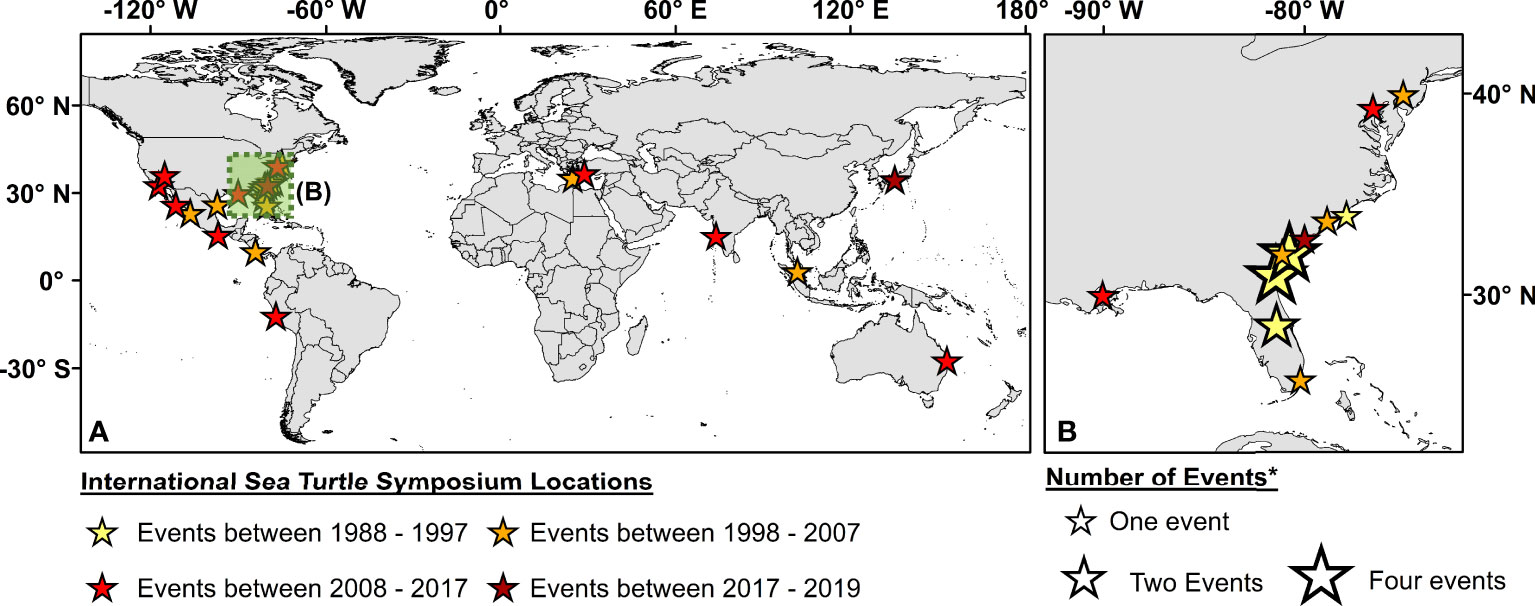
Figure 1 (A) Location of all International Sea Turtle Symposiums between 1988–2019. (B) A zoomed in image of the East Coast of the USA to better reflect the high concentration of events that have occurred in this region. Larger stars represent locations where events have been held at the same location over multiple years.
Presentation formats and authorship
We analyzed 7041 abstracts from 28 ISTS events between 1988–2018, excluding those from 2012, 2015, 2017, and 2019 as the Book of Abstracts for these events were not publicly available at the time of writing this manuscript. Over time, the number of abstracts per event increased from 36 in 1988 to 483 in 2011 (Figure 2). Separating oral and poster presentations revealed that this growth was largely attributable to an increase in poster presentations (Supplementary Material 4). Since 2011, the number of abstracts per event has plateaued.
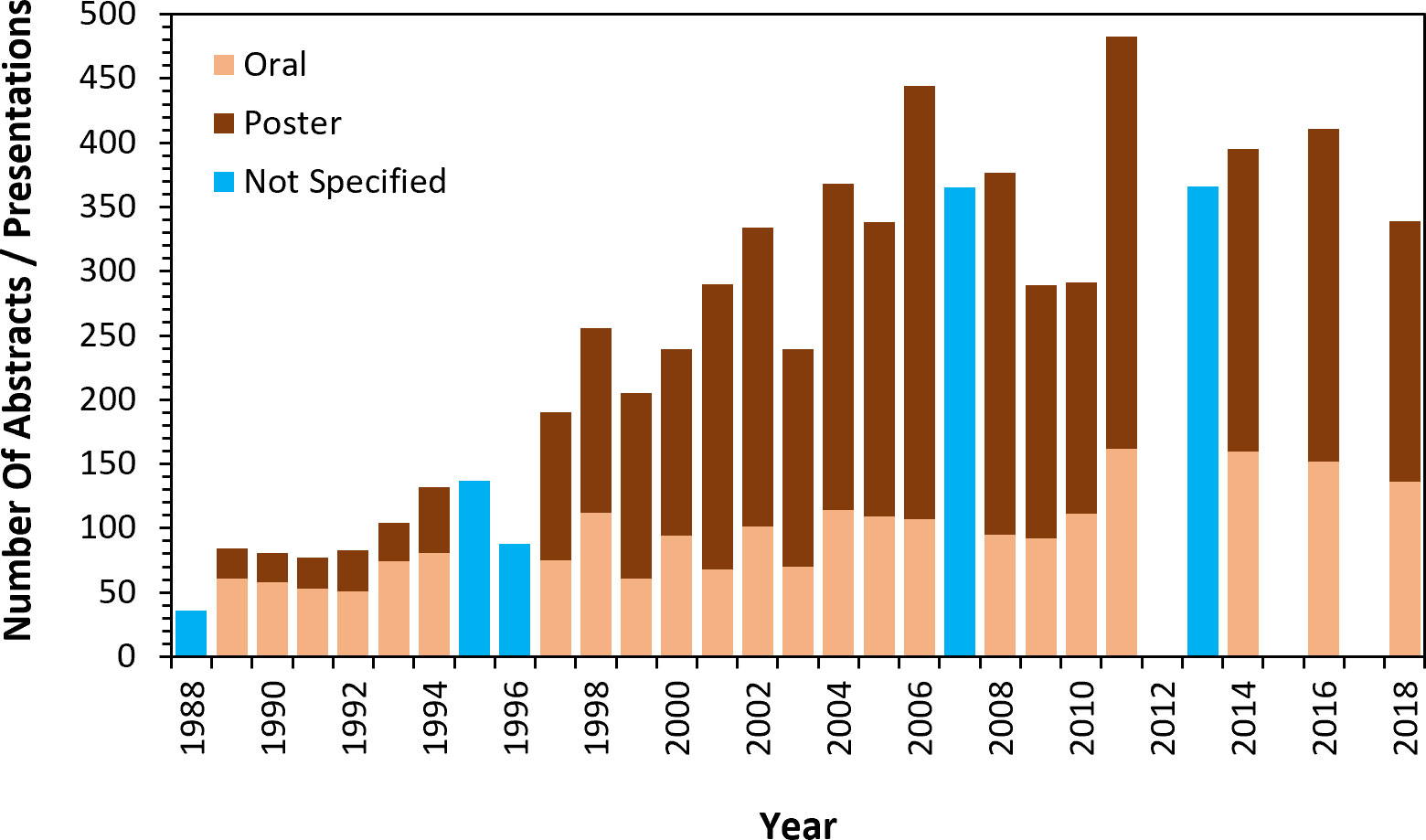
Figure 2 Number of abstracts presented in oral (beige) or poster (brown) format per year at the International Sea Turtle Symposium. Years in blue are for when the Book of Abstracts did not reported on whether presentations were made in an oral or post format.
The mean number of authors per abstract increased steadily at a rate of 0.1 mean number of authors per year, from 2.3 authors per abstract in 1988 to 4.8 in 2018 (Figure 3). The standard deviation of the number of authors also increased steadily from 1.4 in 1988 to 4.2 in 2018.
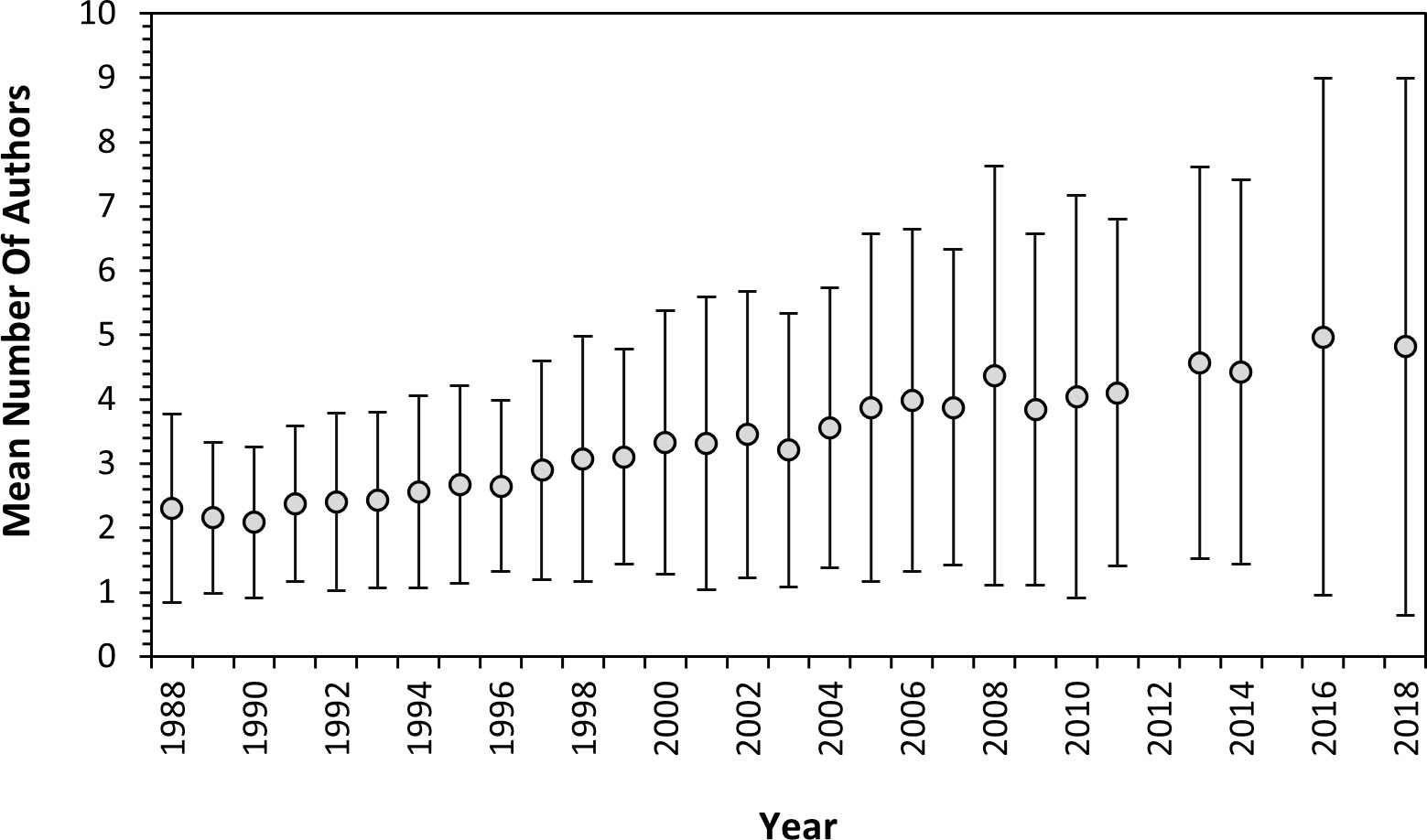
Figure 3 Mean number of authors per abstract annually at the International Sea Turtle Symposium. Error bars = ± 1 SD.
Gender* of first and last authors
The percentage of female first authors increased at a rate of 0.8 per year (Figure 4A). As a result, while only 37% of abstracts had female first authors between 1988–1997, this increased to 53% during 2009–2018. The percentage of female last authors also increased but at a slower rate of 0.4% per year (Figure 4B). Additionally, female last authors remained in the minority over the study period. Specifically, 27% of abstracts had female last authors between 1988–1997 which only increased to 36% during 2009–2018. In 2% of abstracts, the gender* of the first and last authors were not categorized and this never exceeded 8% in a single year.
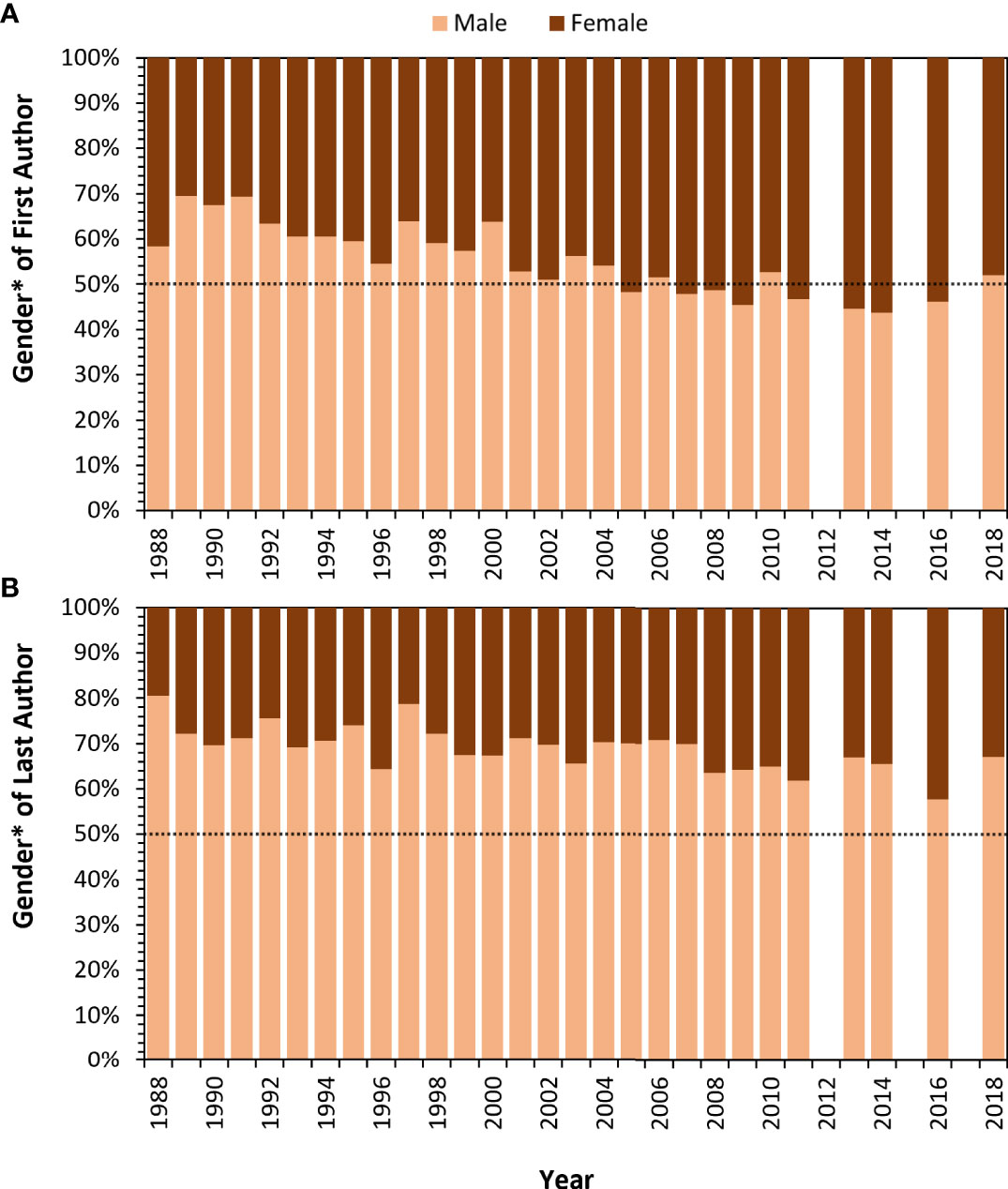
Figure 4 Gender* representation of first (A) and last (B) authors for abstracts presented at the International Sea Turtle Symposium as determined through probabilistic inferences from the authors first name. We use the term gender* (with an asterix) as we only distinguish between male or female. We acknowledge that gender is not binary, and the gender* inferred by an author’s name may not match the author’s self-identified gender. The black line highlights the 50% mark.
Institutional and study site
There was an increasing trend in the total number of countries represented by both institutional and study sites, and there were always more countries represented in study sites than institutional sites (Figure 5). However, it seems that these trends plateaued in 2010. In addition, there was a distinct peak in the number of countries included as study sites between 1989–1991. We were unable to determine the country of the study site for 9% of abstracts and this never exceeded 13% for a single year.
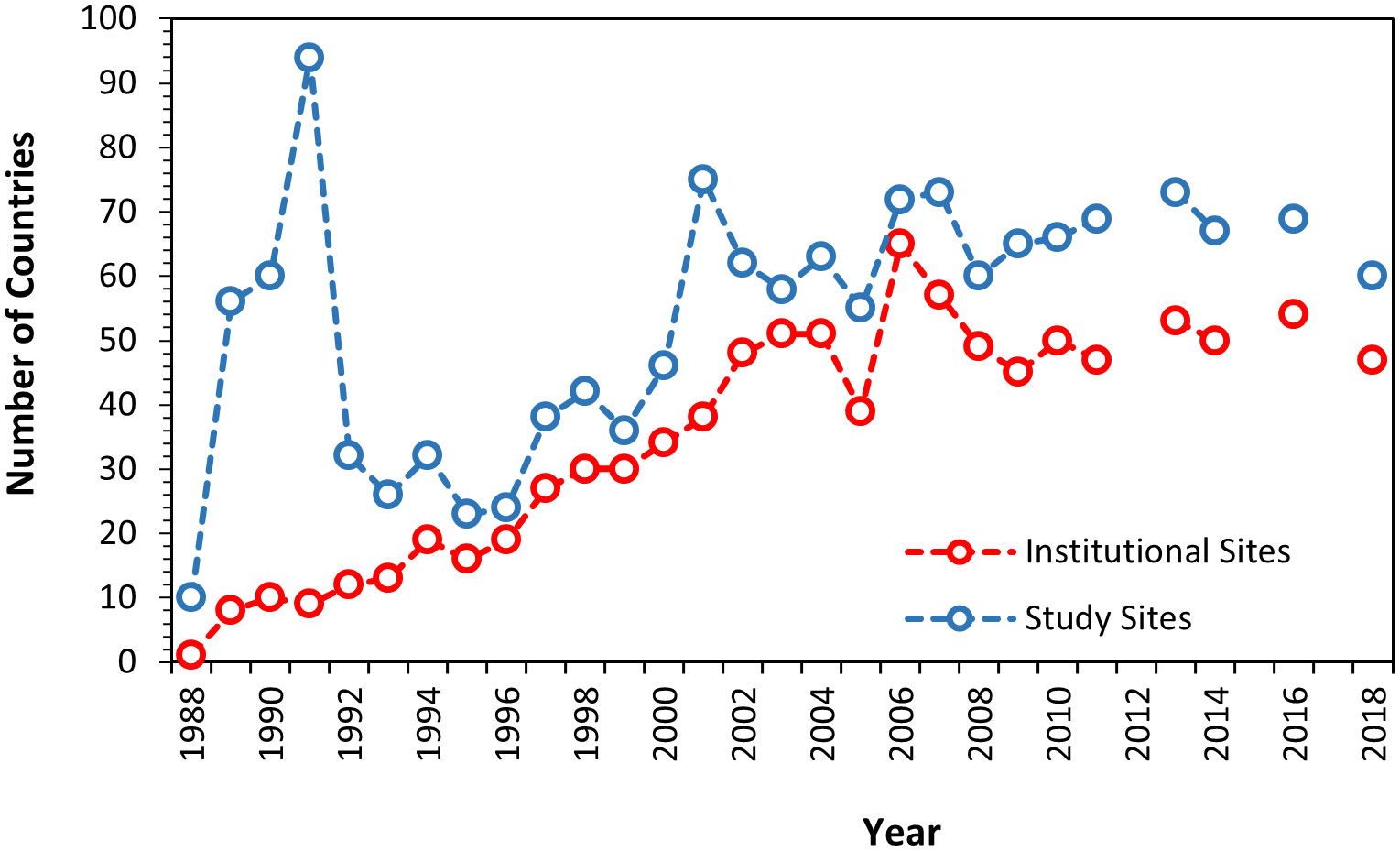
Figure 5 Number of abstracts (black), number of countries represented by institutional sites (red), and number of countries represented by study sites (blue) per year at the International Sea Turtle Symposium.
North America hosted more institutional sites than any other continent for every year except for 1998, 2010, and 2016 when the event was held in Mexico, India, and Peru respectively (Figure 6A). The percentage of abstracts from institutions in North America decreased at a rate of 1.8% per year and from an annual mean of 72% between 1988–1997 to 37% between 2009–2018. The continent with the second highest percentage of institutional sites was Central America and the Caribbean, with 15% of all abstracts over the study period. The percentage of abstracts from institutions in Central America and the Caribbean ranged from 3–39% and slowly increased at a rate of <0.1% per year. Institutions from Africa, Asia, Europe, and Oceania each generally constituted <10% of abstracts per year but this increased at rates between 0.3–0.5% per year. The percentage of abstracts from institutions in Africa, Asia, Europe, Oceania, or South America only exceeded 15% annually when the ISTS was hosted in the same continent. Africa has never hosted an ISTS event and never exceeded 9% of abstracts in a single year.
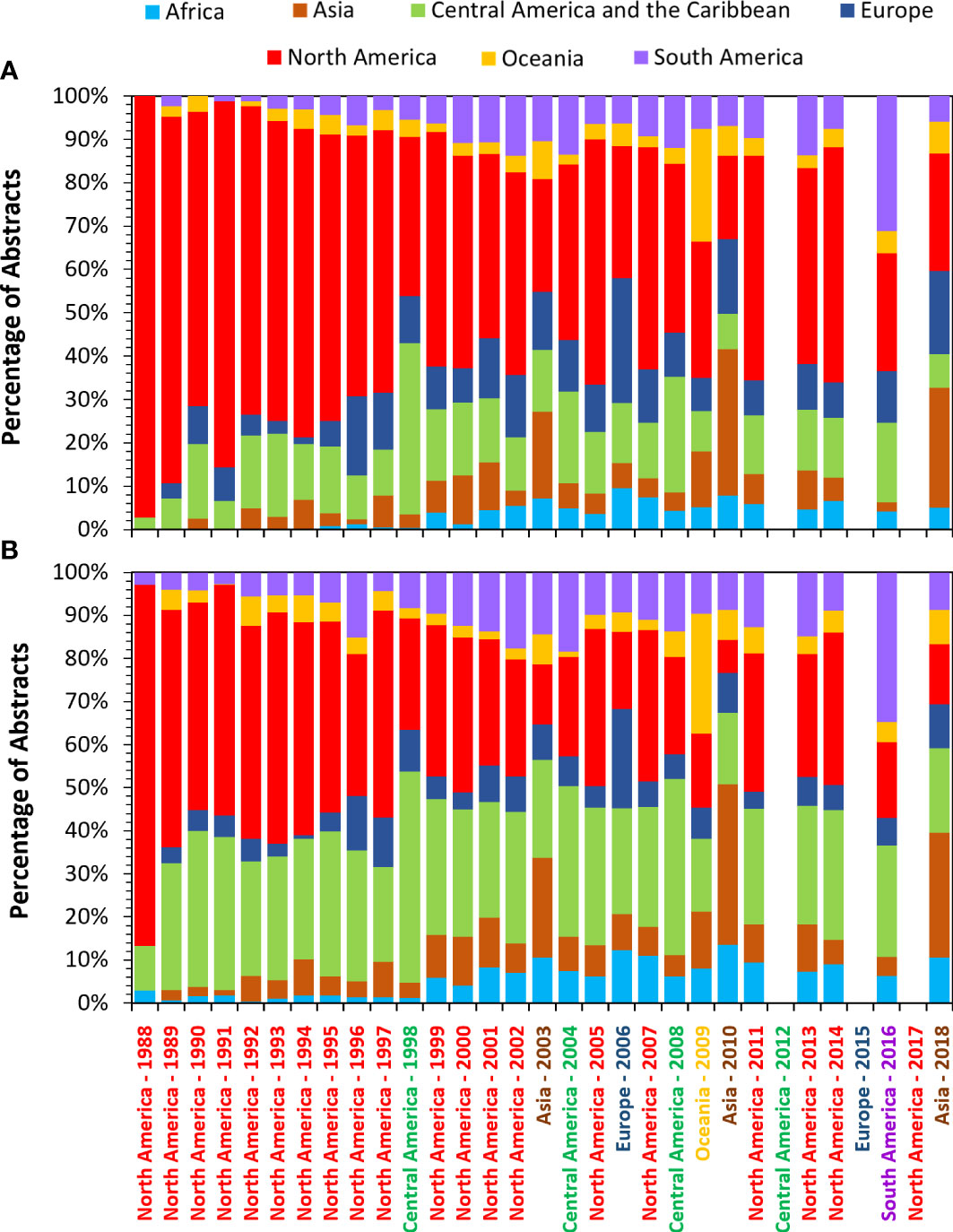
Figure 6 (A) Percentage of institutional sites from different continents at the International Sea Turtle Symposium. (B) Percentage of study sites from different continents at the International Sea Turtle Symposium. The location of the event is indicated alongside the year on the lower x-axis.
Study sites were primarily in North America, which accounted for 29% of all abstracts (Figure 6B), with Central America and the Caribbean as a close second with 28%. Both continents exhibited a general decrease in representation over time, and this decrease of 1.4% per year for North America was far greater than the 0.1% decrease for Central America and the Caribbean. Between 1988–1997, North America and Central America and the Caribbean represented 47 and 25% of all abstracts, respectively, and this decreased to 20 and 22% in 2009–2018. In contrast, increasing trends of 0.1–0.5% per year were observed in study sites from Africa, Asia, Europe, Oceania, and South America. As such, the mean percentage of abstracts with study sites in these continents increased from 1988–1997 to 2009–2018 by 1 to 8% for Africa, 4 to 14% for Asia, 5 to 7% for Europe, 3 to 8% for Oceania, and 5 to 13% for South America.
When comparing percentage representation between institution and study sites, we observed that North America and Europe always had greater representation as institutional sites than study sites (Figures 6A, B). Specifically, the ratio of abstracts from institutional sites compared to study sites was 1:0.6 for both North America and Europe. In contrast, all other continents were more commonly represented by study sites than institutional sites. Specifically, the ratio of institutional to study sites was 1:1.6 for Africa, 1:1.2 for Asia, 1:1.8 for Central America and Caribbean, 1:1.1 for Oceania, and 1:1.3 for South America. Furthermore, almost all abstracts with study site in North America (98%) and slightly less for Europe (93%) were conducted by institutional sites in the same continent (Figure 7A). In contrast, the percentage of abstracts with study sites in the same continent as the institutional sites was lower for Africa (62%), Asia (83%), Central America and Caribbean (55%), Oceania (76%), and South America (79%) (Figure 7A). Viewed from the opposite perspective, the percentage of institutions from North America and Europe with study sites in other continents was 34 and 42% respectively, yet this number was far lower for researchers from institutions in Africa (6%), Asia (3%), Central America and Caribbean (4%), Oceania (19%), and South America (5%) (Figure 7B).
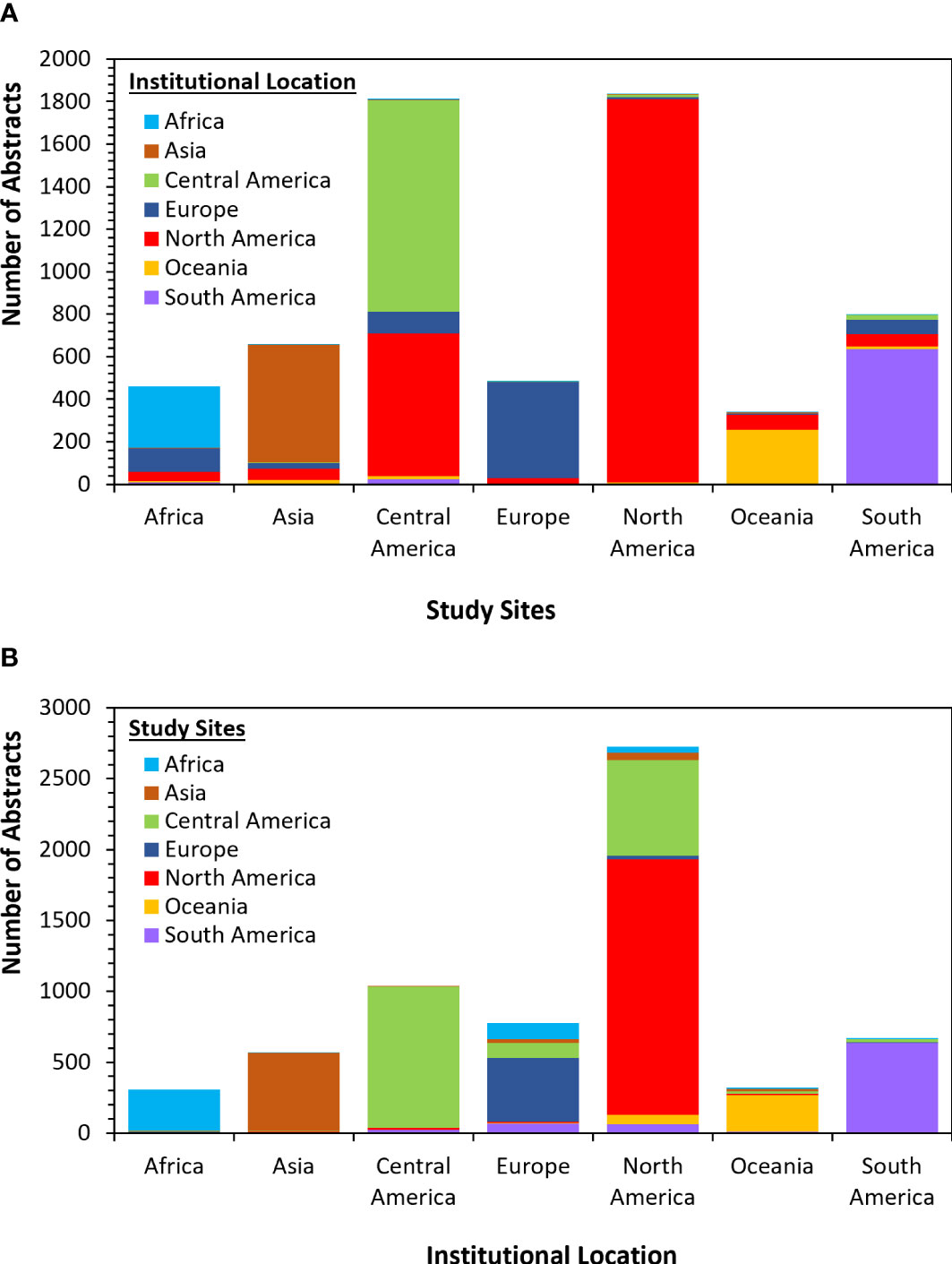
Figure 7 (A) The number of abstracts from study sites in each continent (x-axis). Each bar is divided into separate colors that represent the continent of the institutional site that conducted the research. (B) The number of abstracts from institutional sites in each continent (x-axis). Each bar is divided into separate colors that represent the continent of the study site.
Affiliated institution of the first author
The majority (48%) of institutions were academic (Figure 8). The percentage of academic institutions ranged from 38–57% and exhibited a nominally decreasing trend of <0.1% per year. The prevalence of government affiliations decreased over time at a rate of 0.5% per year, going from an annual mean of 25% of affiliations in 1988-1997 to 16% during 2009-2018. In contrast, non-profits increased from an annual mean of 15% of affiliations between 1988–1997 to 30% during 2009–2018. The least common affiliation category was industry, constituting an annual mean of only 6% of all affiliations and only ranging between years from 4–10%. The number of unknown affiliations was <5% each year.
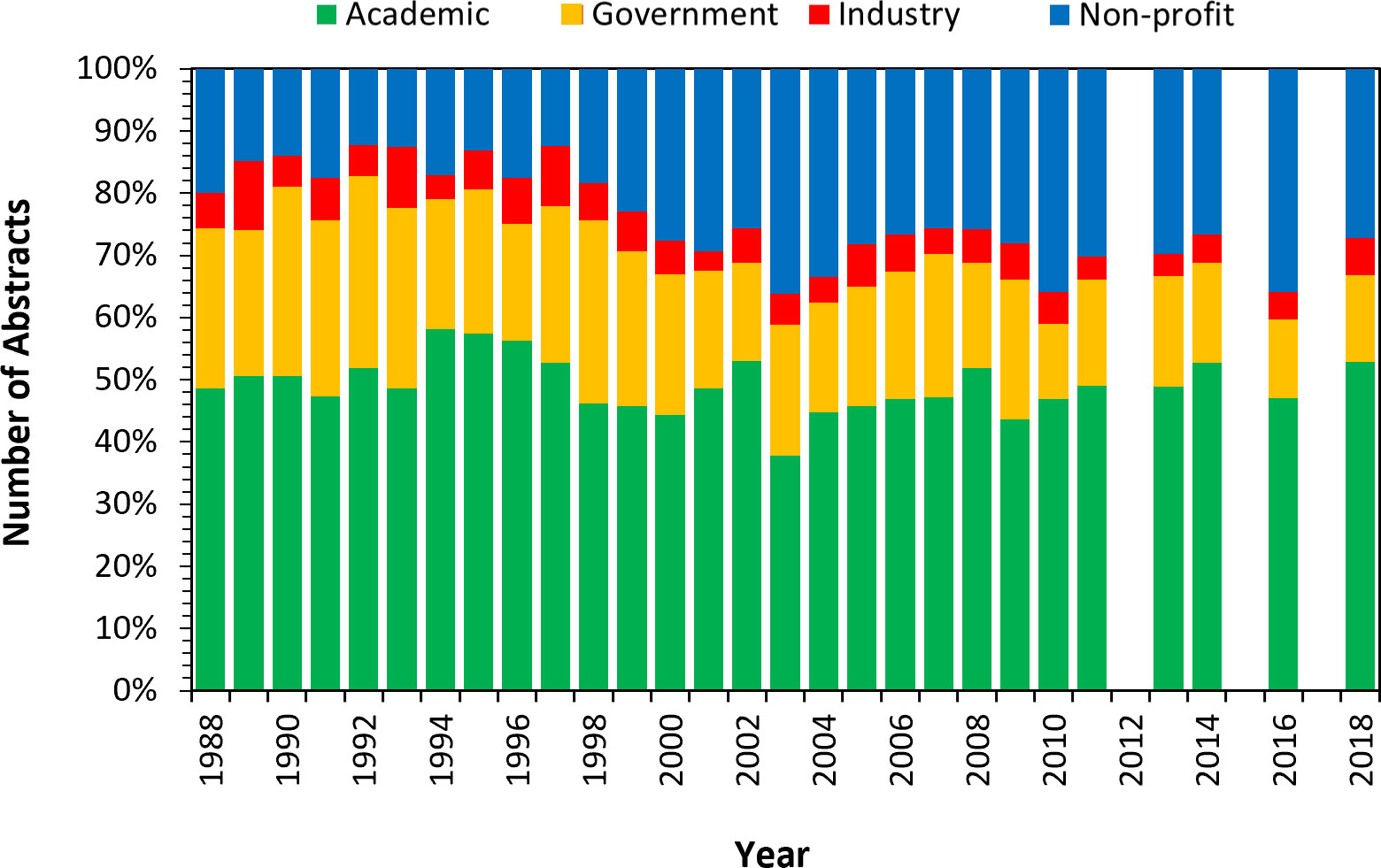
Figure 8 Institutional affiliations of the first authors on abstracts from the International Sea Turtle Symposium.
Discussion
The past decade has seen a rapid increase in awareness about representational biases in academia (Fisher et al., 2012; Pearson and Schuldt, 2014; Kern et al., 2015). By quantifying such biases we gain an objective viewpoint from which we can design effective measures for promoting equity (Casad et al., 2021). Within this context, we assessed long-term trends in geographic and gender representation within the sea turtle community by analyzing thirty years of abstracts presented at the ISTS.
Increasing co-authorship
We observed a consistent increase in the number of authors per abstract, resulting in an almost doubling of this metric over the study period. Predictably, this trend was also observed by Mazaris et al. (2018) in the number of authors on articles published in scientific journals on sea turtle biology. Mazaris et al. (2018) used network analysis to infer that this trend reflected a growth in collaborative networks internationally, and this is likely also the case here. Indeed, the increase in the number of co-authors per abstract that we observed also coincided with a general trend towards a greater geographic diversity of study sites (Figure 6B). Another key factor supporting the growth in the numbers of co-authors on both abstracts at the ISTS and published literature could also be changing opinions towards what is needed for co-authorship. While efforts are being made to standardize authorship in scientific fields (Brand et al., 2015), the process remains largely discretional and can be influenced by seniority as much as contribution (Lissoni and Montobbio, 2015). Thus, a societal change towards a more inclusive and flexible view of the prerequisites for authorship could also lead to an increase in author numbers.
Subjective opinions on authorship could explain why even though an increase was observed in the numbers of authors from both symposium abstracts (reported here) and the scientific literature (Mazaris et al., 2018), the number of authors from abstracts was generally around one individual higher than for scientific literature in equivalent years. This could represent that there is a general pattern for higher number author studies to be presented at conferences yet are never published in the scientific literature. Alternatively, if we accept the assumption that most studies presented at conferences will eventually be published in the scientific literature, one explanation for the difference in the number of authors could be that some researchers are more selective when allocating authorship when publishing in scientific literature than for conference abstracts. To determine whether such “selectivity” is biased towards specific demographics would be an informative direction for future research.
Gender* representation
The prevalence of female first and last authors at the ISTS increased over the study period. Such trends could be partly attributable to efforts within the sea turtle community, and the broader scientific community, to promote female involvement, leadership, and ownership in research and conservation programs (e.g., Husu, 2015; Massey et al., 2021). However, this transition is occurring for first authors at almost double the rate for last authors. Thus, another key factor explaining this trend, and supported by our observation that most abstracts at the ISTS were submitted by authors from academic institutions, could be the increasing trend of female enrollment at universities in numerous countries worldwide (e.g., Booth and Kee, 2011; Winn, 2016). In fact, university enrollment by females has now exceeded male enrollment for almost two decades in North America and Europe (McDaniel, 2013; Conger, 2015). Such trends in university enrollment would likely have a greater effect on first authors than last authors because, in ecological fields, the first author position is usually occupied by the individual that played the largest role in conducting the study while the last author position is reserved for the project’s supervisor (Weltzin et al., 2006). As such, junior-level scientists (e.g., graduate students, post-doctoral fellows) are typically, but not always, first authors while senior scientists are last authors. In turn, this may mean that progress towards gender equity in the sea turtle community is occurring faster at junior, rather than senior, levels. In fact, last authorship at the ISTS is still largely male dominated.
If both male and female junior-level scientists were equally likely to remain in the field of science, the trend for increasing proportions of female first-authors should be mirrored in last-authors but with an appropriate time-lag to account for the time required to transition from a junior to senior scientist. However, the slower increase in female last authors suggests that female scientists are not reaching senior levels. This has been attributed to a lack of retention of women in science, engineering, and technology careers (Servon and Visser, 2011; Holman et al., 2018) and many studies have assessed that there are a multitude of factors biasing against females achieving senior positions in science, including complex interactions between cultural stereotypes, professional and lifestyle choices, and individual ability beliefs (reviewed in Ceci and Williams, 2011). Identifying how these issues affect female retention or promotion within the sea turtle community, and other academic fields, will be key to addressing the gender imbalances currently observed.
Geographic representation
Most institutional and study sites were based in North America at the beginning of the study period but representation across all continents has grown over time. While the number of countries represented both as study sites and institutional sites has plateaued since 2010, the number of abstracts also plateaued around this time. More importantly, the percentage of abstracts from institutional and study sites in under-represented continents, including Africa, Asia, Central America and the Caribbean, and South America, continued to increase beyond this point (Figure 7). This suggests that even though the total number of different countries was not growing, the proportional representation from different regions continued to increase until the end of the study period. Thus, it appears that the globalization of the ISTS does not only reflect the growing size of the event but also increasing representation from different continents.
Such trends reflect increasing globalization of the sea turtle community alongside growing international collaboration (see section Increasing Co-Authorship). Indeed, the large peak in study sites that occurred between 1989 and 1991 can be largely attributed to three key abstracts that specifically discuss efforts to build large multinational collaborations for data generation and knowledge transfer, and such efforts may have had a long-lasting effect within the sea turtle community. Another factor that appears to have supported increasing continental representation at the ISTS could be that the event has been held in an increasing number of countries. Specifically, before 1998 the ISTS was only held in North America but since then has been held in every continent except Africa and Antarctica. The effect of the ISTS on representation is clear, considering that whenever the ISTS is held in a particular region there is a concurrent increase in abstracts submitted from institutions in the host continent. In fact, the only years when institutional representation from Asia, Central America and the Caribbean, Oceania, and South America exceeded 20% of abstracts was when the event was held in that continent.
While this trend towards of globalization is promising, a telling statistic is that the number of countries listed as study sites always exceeded that for institutional sites. In other words, research is frequently conducted in countries that do not have institutional representation at the ISTS. This trend appears to be driven by institutions in North America and Europe as 34 and 42%, respectively, of all abstracts presented by institutions from these regions were conducted internationally (Figure 7A). In contrast, the percentage of abstracts from institutions that conducted research internationally was <6% for Africa, Asia, Central America and the Caribbean, and South America.
Unidirectional trends for higher income countries to conduct research in lower income countries, while the reverse is almost entirely absent, are not unique to the sea turtle community and represent a major inequity within the field of ecology (Stocks et al., 2008; North et al., 2020; Asase et al., 2021). These patterns suggest that trends in global wealth inequality are a key factor behind unequal patterns of geographic representation at the ISTS. One method by which the ISTS has been addressing potential financial barriers for individuals from lower income counties has been the highly successful travel and research grant programs. Yet, knowing that representation is significantly higher when held internationally, efforts could be made for future events to be held in underrepresented regions and notably Africa, which is still to host a single event. Alternatively, incorporating opportunities for individuals to present abstracts remotely via online meeting software to form hybrid online/in-person events could break down barriers associated with the cost of international travel. In support of this latter idea, the most recent ISTS symposium in 2022 was held entirely online and while attendance was lower than in-person events, the number of countries represented exceeded normal levels (anonymous reviewer, personal communication).
Institutional representation
Academic institutions were the primary affiliation for most authors each year and represent a key and stable driving force in sea turtle research and conservation. This is comparable to many other fields in wildlife ecology and conservation (Gray et al., 2019, Collins et al., 2020). Governmental institutions were the next most common affiliation; however, this decreased over time and was largely mirrored by a reverse trend in non-profit institutions. Interestingly, a similar trend has been observed in the USA, with government funding for conservation slowly being superseded by non-profit organizations (Bakker et al., 2010). The patterns we observed could therefore either be a product of the large percentage (45%) of institutions from North America in this study or it could indicate that similar trends are also occurring elsewhere around the globe. The reduction in government support from the USA, which is generally retained in-country, and the growing non-profit sector could also play a role in explaining the geographic diversity of both institutional and study sites at the ISTS.
Conclusions
Our analyses revealed that the sea turtle community has made progress toward building larger collaborative networks, improving gender representation at all levels, and expanding the geographic diversity of institutions and study sites. Nevertheless, major representational biases remain - notably, the predominance of male last authors and the greater representation of institutions within North America and Europe when compared to other continents. As such, continued efforts are still needed to develop an inclusive and diverse event that truly fulfills its “international” title. Such efforts will only strengthen the sea turtle community and improve the quality of the science and conservation it conducts.
Data availability statement
Publicly available datasets were analyzed in this study. This data can be found here: https://doi.org/10.5061/dryad.tmpg4f518. This dataset is also available thought direct request from the corresponding author.
Author contributions
NR conceived and designed the analyses, extracted data from the abstracts, conducted the data analyses, and wrote the article. All other authors helped extract data from the abstracts and provided constructive feedback on manuscript. All authors contributed to the article and approved the submitted version.
Funding
NR was funded by the Spanish government (AEI) through the ‘Severo Ochoa Centre of Excellence’ accreditation (CEX2019-000928-S).
Acknowledgments
We would like to graciously thank all the organizers, presenters, and volunteers that have been involved in ISTS since its inception. We thank Ana Miguel Blanco for her essential help in brainstorming the concept behind this manuscript and Harper Hollander for her help with data input.
Conflict of interest
The authors declare that the research was conducted in the absence of any commercial or financial relationships that could be construed as a potential conflict of interest.
Publisher’s note
All claims expressed in this article are solely those of the authors and do not necessarily represent those of their affiliated organizations, or those of the publisher, the editors and the reviewers. Any product that may be evaluated in this article, or claim that may be made by its manufacturer, is not guaranteed or endorsed by the publisher.
Supplementary material
The Supplementary Material for this article can be found online at: https://www.frontiersin.org/articles/10.3389/fmars.2022.943056/full#supplementary-material
References
Ahmadia G. N., Cheng S. H., Andradi-Brown D. A., Baez S. K., Barnes M. D., Bennett N. J., et al. (2021). Limited progress in improving gender and geographic representation in coral reef science. Front. Mar. Sci. 8. doi: 10.3389/fmars.2021.731037
AlShebli B. K., Rahwan T., Woon W. L. (2018). The preeminence of ethnic diversity in scientific collaboration. Nat. Commun. 9 (1), 1–10. doi: 10.1038/s41467-018-07634-8
Asase A., Mzumara-Gawa T. I., Owino J. O., Peterson A. T., Saupe E. (2021). Replacing “parachute science” with “global science” in ecology and conservation biology. Conserv. Sci. Pract., 4(5), e517. doi: 10.1111/csp2.517
Bakker V. J., Baum J. K., Brodie J. F., Salomon A. K., Dickson B. G., Gibbs H. K., et al. (2010). The changing landscape of conservation science funding in the united states. Conserv. Lett. 3, 435–444. doi: 10.1111/j.1755-263X.2010.00125.x
Booth A. L., Kee H. J. (2011). A long-run view of the university gender gap in Australia. Aust. Economic History Rev. 51 (3), 254–276. doi: 10.1111/j.1467-8446.2011.00329.x
Brand A., Allen L., Altman M., Hlava M., Scott J. (2015). Beyond authorship: Attribution, contribution, collaboration, and credit. Learned Publishing 28 (2), 151–155. doi: 10.1087/20150211
Campbell L. M., Smith C. (2006). What makes them pay? values of volunteer tourists working for sea turtle conservation. Environ. Manage. 3, 84–98. doi: 10.1007/s00267-005-0188-0
Casad B. J., Franks J. E., Garasky C. E., Kittleman M. M., Roesler A. C., Hall D. Y., et al. (2021). Gender inequality in academia: Problems and solutions for women faculty in STEM. J. Neurosci. Res. 99 (1), 13–23. doi: 10.1002/jnr.24631
Casale P., Rees A. F., Margaritoulis D. (2005). Fourth reunion of Mediterranean sea turtle specialists at the 25th annual symposium on Sea turtle conservation and biology. Mar. Turtle Newslett. 108, 22.
Ceci S. J., Williams W. M. (2011). Understanding current causes of women's underrepresentation in science. Proc. Natl. Acad. Sci. U.S.A., 108(8), 3157–3162. doi: 10.1073/pnas.1014871108
Collins M. K., Magle S. B., Gallo T. (2021). Global trends in urban wildlife ecology and conservation. Biol. Conserv. 261, 109236. doi: 10.1016/j.biocon.2021.109236
Conger D. (2015). High school grades, admissions policies, and the gender gap in college enrollment. Economics Educ. Rev. 46, 144–147. doi: 10.1016/j.econedurev.2015.03.003
de Vos A., Schwartz M. W. (2022). Confronting parachute science in conservation. Conserv. Sci. Pract. 4 (5). doi: 10.1111/csp2.12681
Fisher R., Maginnis S., Jackson W., Barrow E., Jeanrenaud S. (2012). Linking conservation and poverty reduction: Landscapes, people and power. 1st ed (London, United Kingdom:Routledge). doi: 10.4324/9781849771849
Gaughran S. (2012). The content and culture of the international Sea turtle symposium. Mar. Turtle Newslett. 134, 23.
Gray S. M., Booher C. R., Elliott K. C., Kramer D. B., Waller J. C., Millspaugh J. J., et al. (2020). Research-implementation gap limits the actionability of human-carnivore conflict studies in East Africa. Anim. Conserv. 23, 7–17. doi: 10.1111/acv.12520
Haelewaters D., Hofmann T. A., Romero-Olivares A. L. (2021). Ten simple rules for global north researchers to stop perpetuating helicopter research in the global south. PLoS Comput. Biol. 17, e1009277. doi: 10.1371/journal.pcbi.1009277
Hanks P., Hardcastle K., Hodges F. (2006). A dictionary of first names (Oxford, United Kingdom: Oxford University Press). doi: 10.1093/acref/9780198610601.001.0001
Heithaus M. R. (2013). Predators, prey, and the ecological roles of Sea turtles. Biol. Sea Turtles III, 249.
Holman L., Stuart-Fox D., Hauser C. E. (2018). The gender gap in science: How long until women are equally represented? PLoS Biol. 16, e2004956. doi: 10.1371/journal.pbio/2004956
Husu L. (2015). A comprehensive national approach to promote gender equality in science: The case of Norway. Advancing Women Sci., (pp. 327–329). Cham, Switzerland: Springer. doi: 10.1007/978-3-319-08629-3
Kern C. C., Kenefic L. S., Stout S. L. (2015). Bridging the gender gap: The demographics of scientists in the USDA forest service and academia. Bioscience 65, 1165–1172. doi: 10.1093/biosci/biv144
Kot C. Y., Åkesson S., Alfaro-Shigueto J., Amorocho Llanos D. F., Antonopoulou M., Balazs G. H., et al. (2022). Network analysis of sea turtle movements and connectivity: A tool for conservation prioritization. Diversity Distributions 28, 810–829. doi: 10.1111/ddi.13485
Larivière V., Ni C., Gingras Y., Cronin B., Sugimoto C. R. (2013). Bibliometrics: Global gender disparities in science. Nature 504, 211–213. doi: 10.1038/504211a
Lissoni F., Montobbio F. (2015). Guest authors or ghost inventors? inventorship and authorship attribution in academic science. Eval. Rev. 39 (1), 19–45. doi: 10.1177/0193841X13517234
Massey L. M., Camerden P. M., Gaos A. R., Liles M. J., Seminoff J. A., Ahern A. L. M. (2021). Challenging gender inequity in wildlife conservation: A women’s group leading sea turtle conservation efforts in El Salvador. Local Environ. 27, 1–15. doi: 10.1080/13549839.2021.1997962
Mazaris A. D., Gkazinou C., Almpanidou V., Balazs G. (2018). The sociology of sea turtle research: evidence on a global expansion of co-authorship networks. Biodiv. Conserv. 27, 1503–1516. doi: 10.1007/s10531-018-1506-1
Mazaris A. D., Schofield G., Gkazinou C., Almpanidou V., Hays G. C. (2017). Global sea turtle conservation successes. Sci. Adv. 3 (9), e1600730. doi: 10.1126/sciadv.1600730
McDaniel A. (2013). Parental education and the gender gap in university completion in Europe. Demographic Res. 29, 71–84. doi: 10.4054/DemRes.2013.29.3
Moed H. F. (1989). The use of bibliometric indicators for the assessment of research performance in the natural and life sciences (Leiden: DSWO Press). doi: 10.1016/0048-7333(85)90012-5
North M. A., Hastie W. W., Hoyer L. (2020). Out of Africa: The underrepresentation of African authors in high-impact geoscience literature. Earth-Sci. Rev. 208, 103262. doi: 10.1016/j.earscirev.2020.103262
Passos M. J., Matta G., Lyra T. M., Moreira M., Kuper H., Penn-Kekana L., et al. (2020). The promise and pitfalls of social science research in an emergency: lessons from studying the zika epidemic in Brazil 2015-2016. BMJ Global Health 5, e002307. doi: 10.1136/bmjgh-2020-002307
Patel S. H., Morreale S. J., Panagopoulou A., Bailey H., Robinson N. J., Paladino F. V., et al. (2015). Changepoint analysis: A new approach for revealing animal movements and behaviors from satellite telemetry data. Ecosphere 6 (12), 1–13. doi: 10.1890/ES15-00358.1
Pearson A. R., Schuldt J. P. (2014). Facing the diversity crisis in climate science. Nat. Climate Change 4, 1039–1042. doi: 10.1038/nclimate2415
Pinou T., Domenech F., Lazo-Wasem E., Majewska R., Pfaller J., Zardus J., et al. (2019). Standardizing sea turtle epibiont sampling: outcomes of the epibiont workshop at the 37th international Sea turtle symposium. Mar. Turtle Newslett., 157, 22–32.
Robinson N. J., Morreale S. J., Nel R., Paladino F. V. (2016). Coastal leatherback turtles reveal conservation hotspot. Sci. Rep. 6 (1), 1–9. doi: 10.1038/srep37851
Rudd L. F., Allred S., Bright Ross J. G., Hare D., Nkomo M. N., Shanker K., et al. (2021). Overcoming racism in the twin spheres of conservation science and practice. Proc. R. Soc. B 288 (1962), 20211871. doi: 10.1098/rspb.2021.1871
Salerno P. E., Páez-Vacas M., Guayasamin J. M., Stynoski J. L. (2020). Correction: Male principal investigators (almost) don’t publish with women in ecology and zoology. PLoS One 15 (5), e0233803. doi: 10.1371/journal.pone.0233803
Servon L. J., Visser M. A. (2011). Progress hindered: The retention and advancement of women in science, engineering and technology careers. Hum. Resource Manage. J. 21 (3), 272–284. doi: 10.1111/j.1748-8583.2010.00152.x
Shiffman D. S., Ajemian M. J., Carrier J. C., Daly-Engel T. S., Davis M. M., Dulvy N. K., et al. (2020). Trends in chondrichthyan research: An analysis of three decades of conference abstracts. Copeia 108, 122–131. doi: 10.643/OT-19-179R
Stefanoudis P. V., Licuanan W. Y., Morrison T. H., Talma S., Veitayaki J., Woodall L. C. (2021). Turning the tide of parachute science. Curr. Biol. 31, 184–185. doi: 10.1016/j.cub.2021.01.029
Stocks G., Seales L., Paniagua F., Maehr E., Bruna E. M. (2008). The geographical and institutional distribution of ecological research in the tropics. Biotropica 40, 397–404. doi: 10.1111/j.1744-7429.2007.00393.x
Tisdell C., Wilson C. (2001). Wildlife-based tourism and increased support for nature conservation financially and otherwise: evidence from sea turtle ecotourism at Mon repos. Tourism Economics 7, 233–249. doi: 10.5367/000000001101297847
UNSD (2022) United nations geoscheme. Available at: https://unstats.un.org/unsd/methodology/m49/ (Accessed 28-Mar-2022).
Wallace B. P., DiMatteo A. D., Bolten A. B., Chaloupka M. Y., Hutchinson B. J., Abreu-Grobois F. A., et al. (2011). Global conservation priorities for marine turtles. PLoS One 6, e24510. doi: 10.1371/journal.pone.0024510
Wallace B. P., DiMatteo A. D., Hurley B. J., Finkbeiner E. M., Bolten A. B., Chaloupka M. Y., et al. (2010). Regional management units for marine turtles: A novel framework for prioritizing conservation and research across multiple scales. PLoS One 5, e15465. doi: 10.1371/journal.pone.0015465
Weltzin J. F., Belote R. T., Williams L. T., Keller J. K., Engel E. C. (2006). Authorship in ecology: Attribution, accountability, and responsibility. Front. Ecol. Environ. 4 (8), 435–441. doi: 10.1890/1540-9295(2006)4[435:AIEAAA]2.0.CO;2
Winn M. K. (2016). Women in higher education in Iran: how the Islamic revolution contributed to an increase in female enrollment. Global Tides 10 (1), 10.
Keywords: demography, conservation, marine biology, international sea turtle symposium, conference, diversity, congress
Citation: Robinson NJ, Mills S, St.Andrews L, Sundstrom A, Thibodeau J, Yaney-Keller A and Gatto CR (2022) Representation in sea turtle science: Slow progress towards gender equity and globalization revealed from thirty years of symposium abstracts. Front. Mar. Sci. 9:943056. doi: 10.3389/fmars.2022.943056
Received: 13 May 2022; Accepted: 21 July 2022;
Published: 16 August 2022.
Edited by:
Jeffrey C. Mangel, Prodelphinus, PeruReviewed by:
Matthew David Ramirez, University of Rhode Island, United StatesNasreen Peer, Stellenbosch University, South Africa
Copyright © 2022 Robinson, Mills, St.Andrews, Sundstrom, Thibodeau, Yaney-Keller and Gatto. This is an open-access article distributed under the terms of the Creative Commons Attribution License (CC BY). The use, distribution or reproduction in other forums is permitted, provided the original author(s) and the copyright owner(s) are credited and that the original publication in this journal is cited, in accordance with accepted academic practice. No use, distribution or reproduction is permitted which does not comply with these terms.
*Correspondence: Nathan J. Robinson, bmF0aGFuamFja3JvYmluc29uQGdtYWlsLmNvbQ==
 Nathan J. Robinson
Nathan J. Robinson Sophie Mills3
Sophie Mills3 Jadyn Thibodeau
Jadyn Thibodeau Adam Yaney-Keller
Adam Yaney-Keller